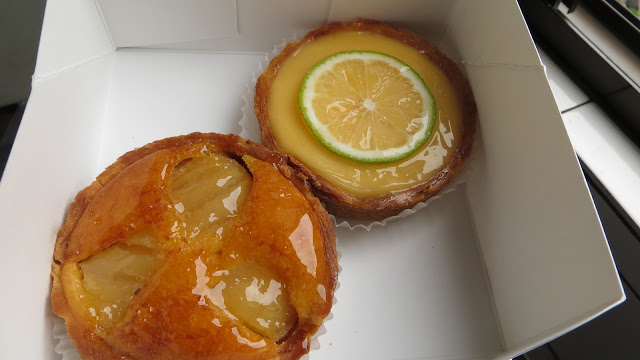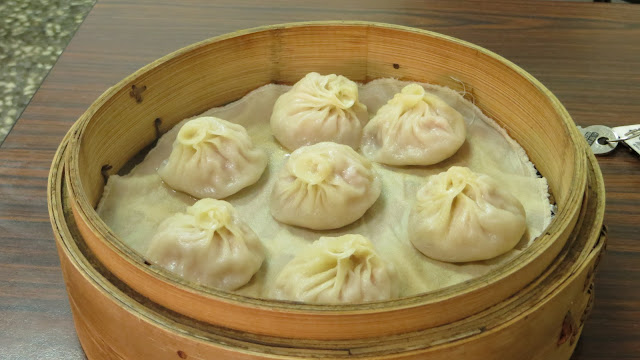STICKY RICE
They are typically flavored with ground pork, dried shrimp and thinly sliced shiitake mushroom. It's important to remember that this is a rice dish so the pork/shrimp/mushroom component really only constitutes about 10% of the total quantity. Additional flavor comes in the form of thickened soy sauce (醬油膏) and hot sauce. Also worth noting is that the rice itself has a unique taste. Overall, it's a very savory and quite dense. The texture is sticky, much more so than the rice you find in your local Chinese joint.
They're typically steamed in little metal cups and, if you watch the video below, you can see one being prepared for takeaway. The pork and shrimp mixture is actually steamed with the rice in the cup:
The second variety of sticky rice doesn't come in a dense, puck-like form and is instead cooked in a regular rice cooker. The grains seem a little longer than those used in the other mi gao. I'm not sure exactly what to call this version in Mandarin because I usually order it in Taiwanese. However, I've seen some people call it you fan (油饭). Phonetically, in Taiwanese, it sounds like bee guh.
In this version, the pork topping is added to the rice after it has already been spooned into the serving bowl. Also, a layer of pureed garlic is there for extra flavor. Lightly salted cucumbers for crunch and chili-bean paste to taste. Next to the bowl is a cup of something which looks like tea. It's not. This is the traditional drink served with the rice and it is, basically, a light fish stock. I don't know exactly what is in it but it tastes like someone steeped katsuobushi in hot water and added a bit of salt.
As far as cost, both version will run you about $1USD.
Here's a quick little map with red dots denoting where I typically go to eat mi gao. The shaded, light green area is the location of my morning market and it's a lot of fun. I recommend it if you like food, are in Taichung and aren't busy at 10AM.
RICE BALL
AKA fan tuan (飯糰). These are simply stuffed balls of rice approximately the size of a baseball. White rice is typical but my rice ball lady is fancy. She uses both white AND black rice. What are they stuffed with? Well, every vendor has his or her own set of ingredients but there will usually be some egg element and chopped you tiao (油條), a very popular type of fried dough. Think sorta like a churro but bigger. They add a nice crunch. My rice ball lady has, among other things, soy braised hard boiled eggs, fried eggs, grilled pork, dried daikon radish, pickled mustard greens, kimchee, ground peanut powder, the previously mentioned you tiao etc. I better just put up this video so you can watch one being made:
And here's the final product. It tastes better than it looks. Cost is ~$1USD.
Here's a map if you want to find my rice ball vendor. It's open only during the mornings so go before noon. It's also pretty easy to order if you don't speak any Chinese because you can just sorta point and they'll figure it out. Most rice ball vendors also serve a couple of drinks like milk tea, soy milk etc.
GUA BAO
Gua bao (刮包), roughly translated, means something totally ridiculous so I'm not gonna include it here. However, they are crazy delicous and are one of my favorite things to eat here in Taiwan. I don't think they are typically eaten as breakfast by many Taiwanese folks but because I only eat them early in the day, I'm gonna include them here. Here's a picture: 

Look familiar? It's probably because David Chang popularized them in the U.S. 5-10 years ago. Around these parts, they are jokingly called "Chinese hamburgers." Anyhow, they consist of a fluffy, clamshell style steamed bun which is stuffed with some sort of meat and various garnishes. Here in Taiwan, soy-braised pork belly is the meat of choice. My vendor also tosses in some pickled mustard greens, crushed peanuts and sugar, cilantro and chili paste. They are delicious:
I know it looks a total mess but it tastes great. A very easy flavor to love with the rich, fatty, salty pork belly, tangy mustard greens, cilantro, sweet peanut and chili warmth. Here's a map to my gua bao vendor:
and here is a picture of her stand. I've circled the characters for gua bao so you have some sort of reference. Her hours are horribly inconsistent but if you go to any night market you'll probably be able to find someone peddling gua bao. They are well worth the effort.
WAH GUI
I don't have the characters to help you out with this one. Sorry. I'm not even sure if wah gui is Mandarin. I'm pretty sure it's Taiwanese. (I have been since told that it is Taiwanese.) All I know is that I saw it one day, wondered what it was and asked the vendor. He gave me some and I've been hooked ever since. Here it is:
As far as I can tell, the white part is rice flour which is cooked and set into a gelatinous state. The topping is thickened soy paste, pork, dried shrimp, diced dried daikon radish and a little white pepper. The rice cake part is very bland and the topping is very flavorful so you have to get a little of each in every bite. I'm also told that this is typically served to little kids. Maybe it's because the rice cake part is easy to digest? At any rate, I really like gua gui and, even here, it's not commonly found. There is also a sweet version which adds Taiwanese brown sugar to the rice cake.
MEE SUAH
Mee suah is the Taiwanese name for this dish. In Mandarin, it is called mien xien (面线). If I can be trusted, mien (面) means "noodle" and xien (线) means "line" so "noodle line." I think this has to do with how thin the wheat based noodles are. Or maybe it's because the noodles are traditionally air-dried outdoors strung out on lines, like clothes. I intentionally used the Taiwanese name when introducing this dish because that's how most people order it, even if they usually speak Mandarin. To me, it's inextricably associated with Taiwan. It's EVERYWHERE here in Taichung and, the farther south you go, the more Taiwanese the people and the more mee suah you find. Here's a picture:
 So, the mee suah is quite thick due (I think) to the starch released by the noodles. I've never figured out why the noodles don't completely disintegrate during the extended cooking process. The flavor is usually seafood-y. The meatball version seen above is atypical. The default is oyster and thin slices of intestine. I usually see the oysters served raw with just the residual heat of the broth to cook the shellfish through. Also pictured are three condiments. Every bowl is personalized to the diner's taste! Here you see a cup of chili oil, Chinkiang rice vinegar, and some spicy dried daikon radish. One place I really like also gives you a little pureed garlic you can stir into your soup. I LOVE mee suah in its many forms and flavors. It's hearty and I just feel great after knocking back a bowl. This is the front of my favorite mee suah joint:
So, the mee suah is quite thick due (I think) to the starch released by the noodles. I've never figured out why the noodles don't completely disintegrate during the extended cooking process. The flavor is usually seafood-y. The meatball version seen above is atypical. The default is oyster and thin slices of intestine. I usually see the oysters served raw with just the residual heat of the broth to cook the shellfish through. Also pictured are three condiments. Every bowl is personalized to the diner's taste! Here you see a cup of chili oil, Chinkiang rice vinegar, and some spicy dried daikon radish. One place I really like also gives you a little pureed garlic you can stir into your soup. I LOVE mee suah in its many forms and flavors. It's hearty and I just feel great after knocking back a bowl. This is the front of my favorite mee suah joint:
Check out the giant vat of soup:
A picture of the menu with the mee suah items circled. They make a couple of versions. Astute readers will also see that they make gua bao:
Here's where the shop is located but, as I said before, mee suah is available EVERYWHERE.
SHAO BING
Shao bing (烧饼) is a type of baked bread which is from Northern China. See, you have to remember that rice reigns supreme in Southern China but Northern China has a climate more amenable to wheat farming so they mill a lot of wheat into flour which is then turned into noodles and bread. Shao (烧) means "baked" and bing (饼) is a word used to describe flat, disc shaped objects so it's easy to understand where the name comes from. They can be filled or unfilled and, if filled, either savory or sweet. They also come topped with sesame seeds or without. For breakfast, I get mine filled with a scrambled egg. Please notice how nice and flaky it is:
Please notice how nice and flaky it is:
 Please notice how nice and flaky it is:
Please notice how nice and flaky it is:
I get my shao bing from the same person who makes my soup dumplings. I wonder why he specializes in two Northern Chinese dishes? Here's a picture of the vendor's setup. You'll see the oven in the middle of the picture and a flat griddle next to it. The griddle is used to fry up bacon/ham, eggs, etc. Next to the griddle is the steaming implement for the soup dumplings.
Well, that about does it for this far too long post. Hope you enjoyed learning about some of your possible breakfasts if you ever visit Taiwan!!!
(Chinese readers, sorry if I screwed up any of the characters. I tried my best. :P )































